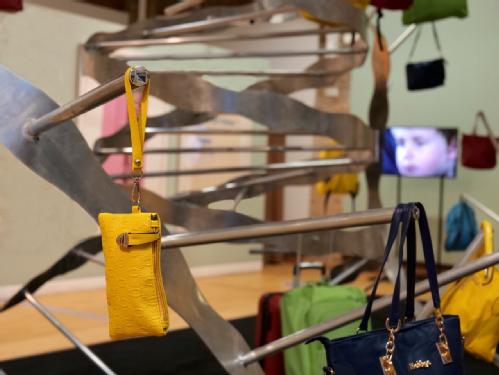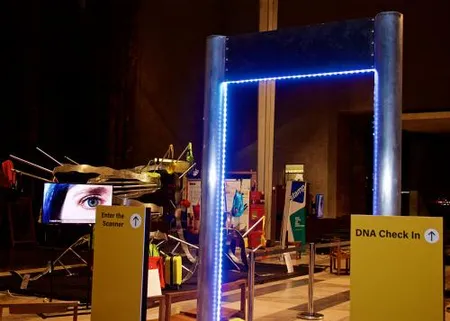I:DNA
Background
I:DNA is a Wellcome Trust funded project that was created to engage the public with research led by Professor Felicity Boardman, in conjunction with Dr Corinna Clark, at Warwick Medical School. The research explores the experiences of people living with inherited conditions and their attitudes towards genetic medicine.
This video provides an overview of the art installation produced to explore these themes.
You may also be interested in the write up of learnings from the evaluation of the I:DNA project in Research for All - Boardman, F.K., Clark, C.C., Buck, R. and Hundt, G.L. (2023) ‘I:DNA – Evaluating the impact of public
engagement with a multimedia art installation on genetic screening’. Research for All, 7 (1), 15. DOI: https://doi.org/10.14324/RFA.07.1.15Link opens in a new window.
About the research
While the general public generally have limited (or no) knowledge of genetic conditions, it is estimated that most people are a ‘carrier’ of at least one genetic condition. This means that they will have one copy of a gene that is associated with a genetic condition, but they will not have the condition themselves (because they also have one fully functioning gene copy). However, their children, or grandchildren, could potentially have the condition if they inherit a second faulty copy of the gene form their other parent. Cystic fibrosis is the most common inherited condition in the UK with around 1 in 25 people being a carrier, though most people be unaware that they carry cystic fibrosis until they – or a family a member – has a child diagnosed with the condition.

There is increasing incorporation of genomic medicine into healthcare nationally and internationally. For example, genetic screening programmes, which screen healthy individuals at a population level, rather than diagnostic genetic testing for people with symptoms of an illness. In the UK, for example, the NHS are piloting whole genome sequencing in up to 200,000 newborn babies. The increasing use of genetic screening means that more people than ever will have access to their (or their child’s) genetic information. This information can be used to inform an individual’s healthcare and reproductive decisions, but will also have significant social and ethical consequences for future generations and wider society.
Historically, the views of people already living with genetic conditions have been underexplored in debates about the pros and cons of genetic screening. Yet, they can offer important insights into what it is like to live with a genetic condition, the complexities around their own reproductive choices, as well as their perceptions of what ‘a life worth living’ is. Their views are also important to debates around how genetic screening might change wider society, such as preventing the birth of babies with genetic conditions, and how this could impact on those people living with genetic conditions, though, for example, greater stigma and reduced investment in treatments and support.
Through her work, Felicity has ensured that the voices of people with ‘lived experience’ of genetic conditions are included in debates about genetic screening at a policy level (e.g. UK National Screening Committee). Publicising their viewpoints and experiences to as wide a ‘lay’ audience as possible is critical to the wider research aims, of informing ethical debates at a societal level and educating the general public about the different viewpoints surrounding the use of genetic technologies.
Using art for engagement
There were three key reasons for creating an art installation:
- To bring the research to audiences who may not otherwise engage with complex and sensitive research concepts.
- To provide a novel experience that would challenge people to (re)evaluate their knowledge and preconceptions about what living with a rare condition and/or disability might mean.
- To stimulate reflection about how this new knowledge might affect any future ‘genetic decisions’ they may be faced with making. Arts-based public engagement methods have been shown to be effective and accessible means for communicating sensitive research topics in a way that allows the audience room to reflect and form their own views1.
1Ball et al, 2021. Arts-based approaches to public engagement with research: Lessons from a rapid review . Santa Monica, CA: RAND Corporation, 2021. www.rand.org/pubs/research_reports/RRA194-1.html.
I:DNA Installation and Tour

The installation was created in collaboration with a digital theatre and media company, STAMP CIC. Visitors entered the installation through an arch designed to look like an airport body scanner. The focal point of the installation was a large metal sculpture, based on a denaturing DNA helix, with an immersive video/soundscape. The soundscape consisted of spoken and sung verbatim quotes taken from interviews with research participants. Our research participants have lived experience with haemophilia, spinal muscular atrophy, thalassaemia, cystic fibrosis and fragile X syndrome. Alongside these highly personal accounts, video screens displayed filmed portraits of a wide range of diverse faces, highlighting that genomic medicine affects everyone in society. These images were interspersed with statistics about genetic technologies and the frequency of inherited conditions in the general population.
The installation began its tour in 2019, with a preview on the University of Warwick campus (Chaplaincy) followed by an evening showcase at Fargo Village (Coventry) as part of the British Science Festival. This was followed by Oxford Science and Ideas Festival (IF Oxford, October 2019), Coventry Cathedral (part of ESRC Festival of Social Science, November 2019), Millennium Point (Birmingham February 2020). Finally, I:DNA had a 9-month residency at Leamington Spa Art Gallery & Museum (April 2021-January 2022) as part of their 20-year anniversary “Picture of Health: Art, Medicine & the Body” exhibition, completing its tour in January 2022.
Covid-19 Pandemic and I:DNA online
Due to the Covid-19 pandemic, I:DNA’s physical tour was suspended for much of 2020. We participated in the ESRC Festival of Social Science (November 2020) virtually, with an online lecture followed by a Q&A, led by Felicity and with some of the original research participants on the panel.
We also created two films, which were posted on our webpage and were designed to sustain engagement during lockdown restrictions and give I:DNA viewers a chance to engage further with participants’ stories. The first film gave an overview of the background to the project and the research that led to I:DNA, including interviews with some of the research participants. In the second film, our research participants gave their own perspectives of what living through the Covid-19 pandemic was like for people with a genetic condition, many of whom were considered amongst the most vulnerable in society. This Covid-19 video was displayed alongside the I:DNA installation when the tour resumed in 2021 at Leamington Spa Art Gallery & Museum.
I:DNA Associated Activities
To support and extend engagement, several additional activities took place alongside the physical tour and online activities:
- We held launch events at each new venue, where members of the public were invited to hear talks from Felicity and the creative team, and to ask questions. At one of these events (Coventry Cathedral) we also had a live performance from one of the choirs (Gospability) who had provided some of the sung soundscape.
- An ‘invisible theatre’ performance at our Millennium Point launch event (March 2020). Seven drama students from Birmingham City University adopted characters based on the research interview transcripts and mingled with the audience telling their stories (without revealing they were actors). You can read one drama student’s account of the event and see photos here.
- Children’s arts and crafts workshops, ‘I:DNA Who am I?’ (part of ESRC FoSS 2021), held at a local school and at Leamington Spa Art Gallery & Museum. During these workshops, children were shown an age-appropriate talk about genetics by a clinical geneticist, called ‘DNA – what makes me, me?’. The children were invited to create a piece of artwork reflecting their own identities. These were installed in Leamington Spa Art Gallery & Museum (as part of the I:DNA exhibition) by artist Tammy Woodrow for the remainder of I:DNA’s residency.
- A poetry workshop, spoken word performance, and anthology, "DNA Our Stories";Link opens in a new window (as part of the Resonate Festival). Aspiring poets, creative writers, and members of the public were supported by poet Nigel Hutchinson to write poetry inspired by the installation. The poetry was performed at Warwick Arts centre in January 2022 as part of the Resonate festival and collated into an anthology (see webpage).
- An online game iDNAKnowing created by artist Esther Appleyard-Fox. The game, in a futuristic airport setting, encourages participants to go on a journey of ‘genetic’ discovery. Participants choose whether to undergo (imaginary) genetic screening and depending on their choice –and their fictional genetic screening results– the game presents the viewer with alternative realities describing the potential benefits or harms of genetic screening. This is done using the words of people living with rare genetic conditions, taken from the research interviews.
I:DNA Legacy
It is estimated that I:DNA reached over 26,000 people across its various iterations and you can read some of our feedback on our website. Although I:DNA has now completed its tour, the sculpture and soundscape have become part of the University of Warwick’s art collection and are currently displayed in the atrium of the Interdisciplinary Biomedical Research Building (IBRB, Gibbet Hill Campus), to eventually become a permanent feature of the Warwick Arts Sculpture Trail. The resources created during the project will continue to be used for teaching and public engagement and can be found on the I:DNA webpage.
There is a also a paper titled "Evaluating the impact of public engagement with a multimedia art installation on genetic screening" in the journal Research for All.Sharing learning from I:DNA
I:DNA has been a multi-year project with the opportunity to do multiple engagement events around the sculpture. This has provided an opportunity for Felicity and her team to reflect and continually improve on their activities to maximise engagement and impact. The team have provided a series of reflections on different elements of the project that may be useful for you to explore further.
